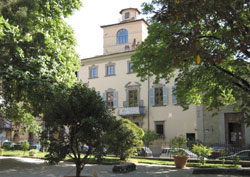Issue: 65 Page: 50-57
The Aboca Museum: Displaying the History of Herbal Medicine in Italy and Europe
by Robin DiPasquale
HerbalGram. 2005; 65:50-57 American Botanical Council
In prehistoric times, knowledge of the healing powers of herbs was passed down orally, often within a family lineage. Sacred clay tablets, hieroglyphics,
then later, books and manuscripts all marked the beginning of written knowledge.
One of the earliest documentations of the medicinal uses of plants is the Ebers
Papyrus, believed to have been written around 1550 BCE.* This Egyptian text describes
500 natural materials and medicinal plants and their properties. Chinese and Ayurvedic
medicine contain texts written between 2700 and 1500 BCE.
Europe holds a significant portion of the history regarding the use of medicinal
plants in health and healing. Empirical medicine began its evolution into a more
scientifically-based medicine through the work of the Greek physician, Hippocrates
(468–377 BCE) in the 5th century BCE. During the Middle Ages in the Roman Empire,
beginning with the 1st and 2nd centuries CE, the Greek physician/herbalist Dioscorides
(whose writings date from ca. 50–70 CE) first catalogued the curative properties
of plants (empirically based on his experiences as a physician) in the five books
of De Materia Medica. Also, Galen (129–199 CE, though some sources say
post 205 CE), physician to Roman emperor Marcus Aurelius, refined the humoral
theory, first introduced by the Hippocratic corpus (i.e., the body of work generally
ascribed to what may be the mythical physician Hippocrates, known as the “father
of medicine”). Galen created a system of medicine whose ideas dominated herbal
medicine in Europe for 1500 years. Some of the principles of this humoral system
are still applied in many strains of traditional herbalism today—the idea that
herbs have energetic properties (e.g., cold, hot, damp, dry) that affect various
bodily “humors” (bile, phlegm, melancholia, etc.). Much later, the famous Persian
physician Avicenna (aka Ibn Sina; 980 – 1037 CE) wrote the Canon of Medicine
in the 11th century CE.
Much of what passed for medicine belonged to the domain of monks in the Christian
monasteries from the 9th through 11th centuries, a tradition still visible in
contemporary Italy and throughout Europe. During the 14th and following centuries,
plants were documented according to their true physical morphology, a focus on
botany. The printed herbal became more available in the 15th century through the
invention of the printing press. The Swiss physician and alchemist Paracelsus
(1493–1541) often called the “father of pharmacology,” traveled extensively throughout
Europe, Russia, and the Middle East studying medicine. He opposed and challenged
Galen’s theories,† opening the doors of herbal medicine in Europe and creating
a potentially new depth for herbs. By introducing the systematic use of heavy
metals, he created a schism in the evolution of medicine, with one branch continuing
to use herbs, and the other, relying more on chemistry, particularly heavy metals
(e.g., lead, mercury). The British physician Nicholas Culpepper (1616–1654), trained
in medicine and pharmacy, translated Latin medical writings dealing with herbs
into English, thereby helping to make herbal medicine more accessible to common
people (who could read English). He reduced the exclusivity of formal herbal medicine
knowledge held by the physicians and apothecaries. In the late 15th century, the
“discovery” of America began the process of the importation and eventual melding
of North American plants into the European materia medica, altering the face of
herbal medicine in Europe.
 The
Aboca Museum, located in central Italy in the historic center of the Tuscan town
of Sansepolcro, is an exquisite and sensate journey through the utilization
of herbs and herbal medicine through the ages. A major cultural and educational
initiative by Aboca, one of Italy’s leading cultivation and manufacturing companies
for medicinal herbs, the museum project was born out of Aboca’s commitment to
the study of historic sources for the medicinal uses of plants and to reviving
their traditional uses in modern times. The
Aboca Museum, located in central Italy in the historic center of the Tuscan town
of Sansepolcro, is an exquisite and sensate journey through the utilization
of herbs and herbal medicine through the ages. A major cultural and educational
initiative by Aboca, one of Italy’s leading cultivation and manufacturing companies
for medicinal herbs, the museum project was born out of Aboca’s commitment to
the study of historic sources for the medicinal uses of plants and to reviving
their traditional uses in modern times.
The museum’s primary goal is to illustrate and document the use of medicinal
herbs throughout the centuries through a large number of artifacts, with an exhibition
that shows how remedies were prepared in different historical periods in various
locations in Europe. In addition, there are several key operating components to
the Aboca Museum:
|